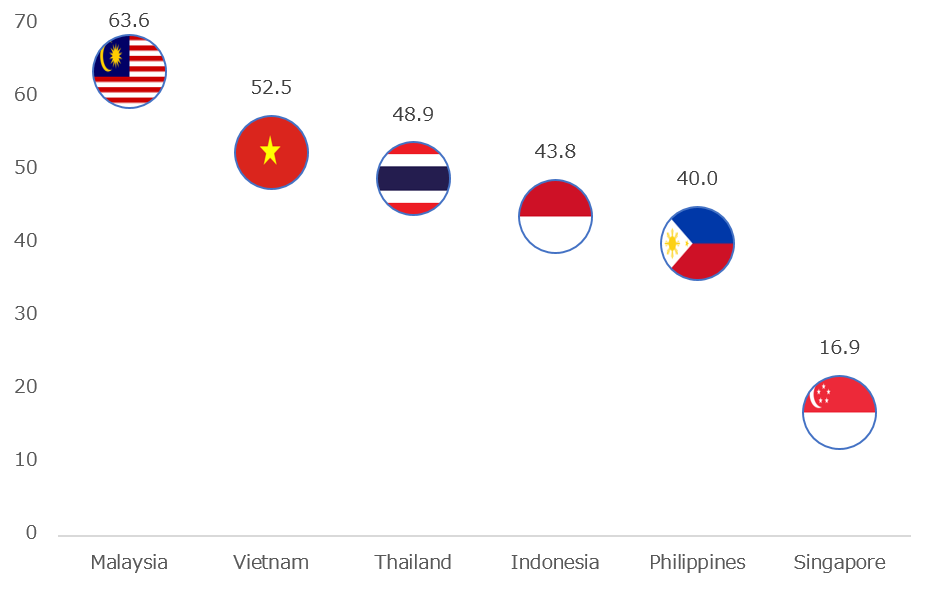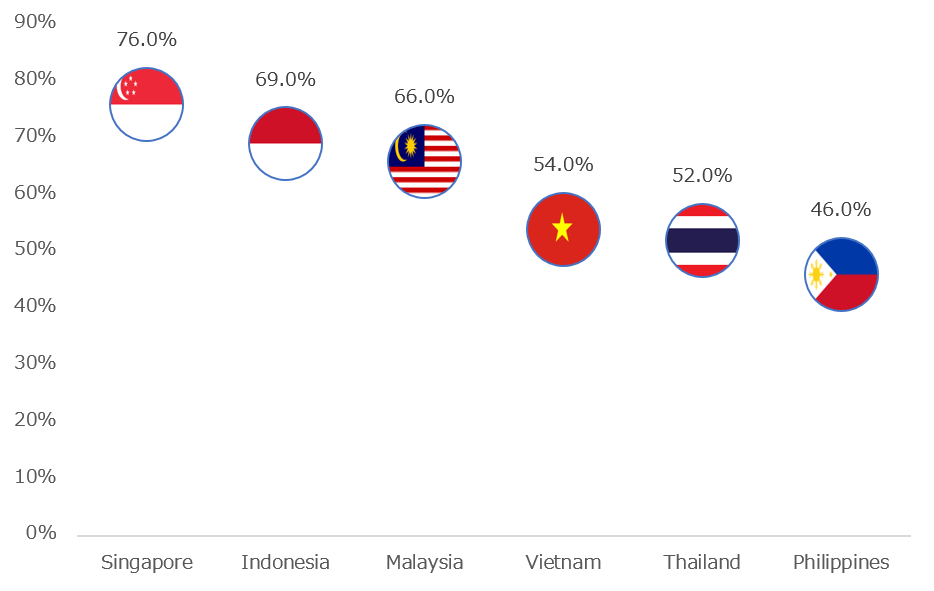Malaysia Plans Cashless Society for 2020 — Is it Out of Reach?
|
In its Financial Sector Blueprint 2011-2020, Malaysia’s central bank set out goals to migrate to an electronic payments system as a step towards achieving a cashless society with modernised financial services and improved efficiency. |
|
To this end, the central bank established specific targets with respect to e-payment transactions per capita, debit card transactions per capita, number of EFTPOS terminals per capita and number of cheques cleared. Moreover, the government launched several initiatives to achieve these targets. While some progress has been made thus far, it is insufficient for Malaysia to successfully reach its goal of becoming cashless by 2020. People’s general reluctance to change and a shortage of aggressive initiatives have hindered the process. By 2016, six years into its endeavour, Malaysia had not met the halfway mark in three of its four targets namely, 1) increasing e-payment transactions per capita, 2) debit card penetration, and 3) EFTPOS terminals penetration. In order for the country to reach the 200 e-payment transactions per capita target by 2020E, it would have to achieve a higher growth rate (19.7%) than it has recorded thus far over 2012-16 (15.7%). Similarly, the country has a significant way to go in meeting its target number of debit card transactions and EFTPOS terminals. Interestingly, Malaysia has recorded a relatively high internet banking penetration rate which bodes well for the country’s transition to cashless transactions. However, it lags quite far behind on other measures such as credit and debit card penetration relative to more developed counterparts. With just a little over three years remaining, a fifth of Malaysia’s projects to achieve greater economic efficiency through electronic payments are yet to commence. As a result, while the country is well on its way to becoming a cashless society, the 2020 timeframe seems unlikely. |
|
Migration to an Electronic Payment System by 2020E, with the Goal of Increasing Financial Sector Efficiency Malaysia’s central bank, Bank Negara Malaysia (BNM), in its Financial Sector Blueprint 2011-2020, announced its plans to migrate to an electronic payments (e-payments) system, making it the preferred medium for economic transactions in order for Malaysia to become a cashless society. BNM aims to increase the number of e-payment transactions to 200 per capita by 2020E from just 44 per capita in 2010. Its other targets are the reduction of cheque transactions, the increase of debit card transactions, and the increase of Electronic Funds Transfer at Point-of-Sale (EFTPOS) terminals. Central Bank Sets Out Four Targets towards Achieving Cashless Society
 Source: Bank Negara Malaysia
Malaysia’s targets and plans to become cashless were modelled after financial sectors in developed countries. Its e-payments goal, for example, benchmarks New Zealand’s; at the time it was setting its target number of e-payments per capita in 2010, Malaysia recorded just 44 compared with New Zealand’s 228 (UK: 249). Malaysia’s E-Payments Goal Benchmarks New Zealand’s (2010)
 Source: Bank Negara Malaysia
BNM Lays Out Five-Part Plan towards Achieving E-Payments Target
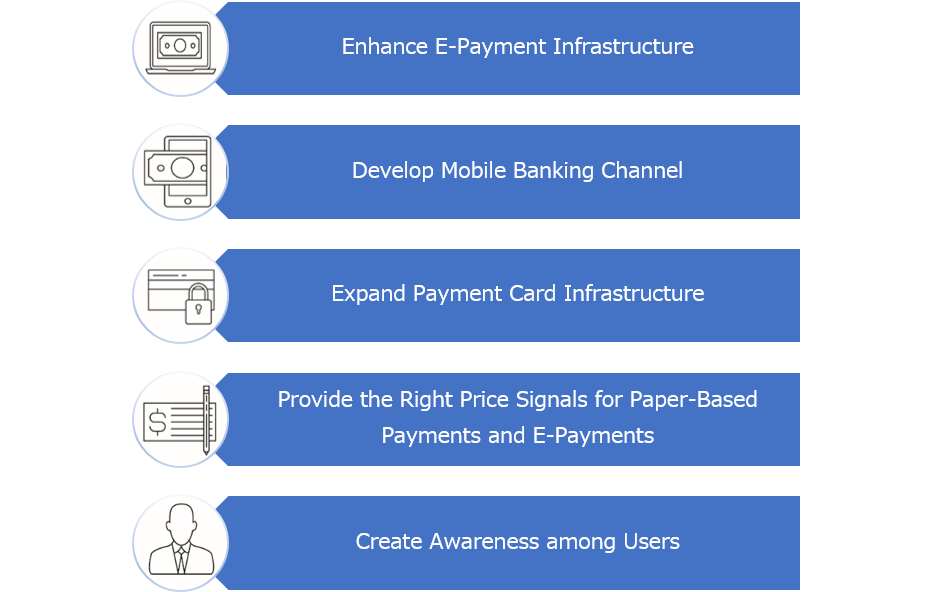 Source: Bank Negara Malaysia
Note: Refer to appendix for the detailed strategy of the plan |
|
Why Does Malaysia Want to Go Cashless? 1) To Achieve Efficiency Gains and Cost Savings International studies show that e-payment transactions cost between just a third and a half of paper-based ones. By migrating completely away from a paper-based payment system, the economy could save 1.0% of the country’s GDP annually (as per BNM), enhancing national competitiveness. 2) To Support Malaysia’s Fast-paced E-commerce Market Malaysia’s e-commerce market is expected to grow at a CAGR of 23.2% to USD 2,585 million in 2021E, from USD 1,121 million in 2017, following a 19.5% CAGR over 2014-16, as per Statista. This growth underpins the need for a good e-payment infrastructure, given that most payments are made online through credit/debit cards and e-money. 3) To Establish a Safer Alternative to Cash amidst High Levels of Snatch Theft The crime rate in Malaysia was the highest among the ASEAN6 in mid-2017, as per the Numbeo Crime Index, followed closely by Vietnam and Thailand. Petty theft such as purse snatching, pickpocketing, smash thefts, and residential burglaries were common, according to the Malaysia 2016 Crime and Safety Report. Consequently, consumers prefer to use cards over cash and are likely to embrace the cashless society concept promoted by BNM. In a survey by Visa in 2015, 66.0% of Malaysian respondents said they preferred cards over cash, with 62.0% believing it was unsafe to carry around cash. Malaysia Records Highest Crime Levels amongst ASEAN6 in Mid-2017
Source: Numbeo
High Preference for Cards over Cash in Malaysia
Source: Visa “Consumer Payment Trends in Southeast Asia” |
|
E-payments: Achievement of Target Requires Pick-up in Growth; Further Expansion in Internet and Mobile Banking, E-Money Transactions, and BNM’s Initiatives Should Help to Some Extent Over 2012-16, Malaysia’s e-payments per capita registered a CAGR of 15.7% to 97.5 transactions per capita in 2016, from 54.4 per capita in 2012. However, if the country is to achieve its target of 200 transactions per capita by 2020, it would have to record a higher CAGR of at least 19.7% over 2016-20E. Mid-Term Goal for 2015 Not Achieved despite Growth in E-payments
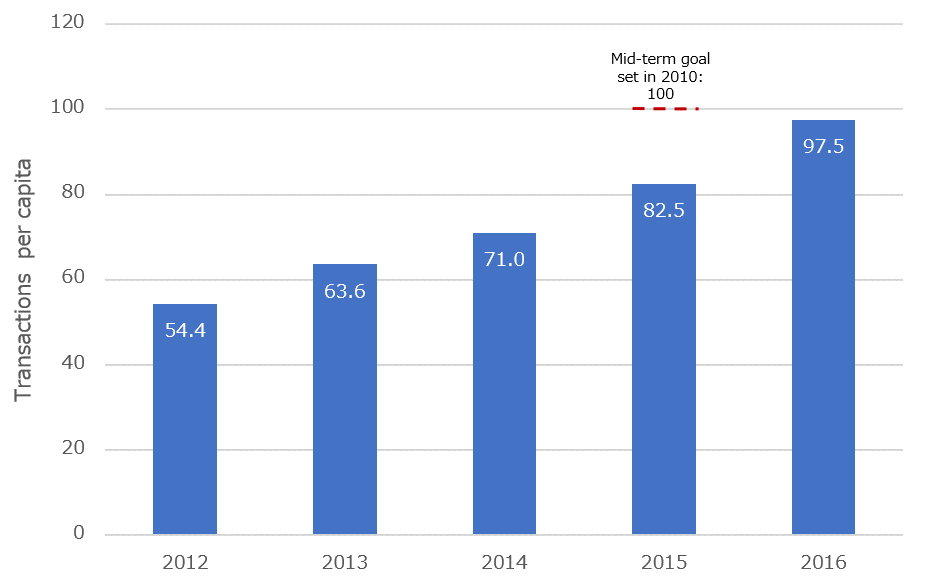 Source: Bank Negara Malaysia
Growth in e-payments is driven by the use of internet and mobile banking, and e-money. Internet banking penetration has seen a steady increase to 71.9% in 2016 from 46.4% in 2012, and stands well above the rate achieved by New Zealand (53.0% in 2011) when the country recorded 200+ e-payments per capita. Despite Malaysia achieving a high level of penetration, this doesn’t seem to have made a significant contribution towards e-payments growth, and brought the country closer to achieving its target. Internet and Mobile Banking See Increasing Popularity due to Acceptance by Younger Population
 Source: Bank Negara Malaysia
Malaysia is expected to see an increase in its credit card penetration to 36.5% by 2020E (as per Statista), from 31.4% in 2016, which is still significantly lower than the 78.0% that New Zealand recorded in 2011. Neighbouring Singapore, is expected to increase its credit card penetration to 53.7% by 2020E, from 45.2% in 2016. Per Capita E-money Transactions Up Steadily while Credit Card Transactions Remain Stable
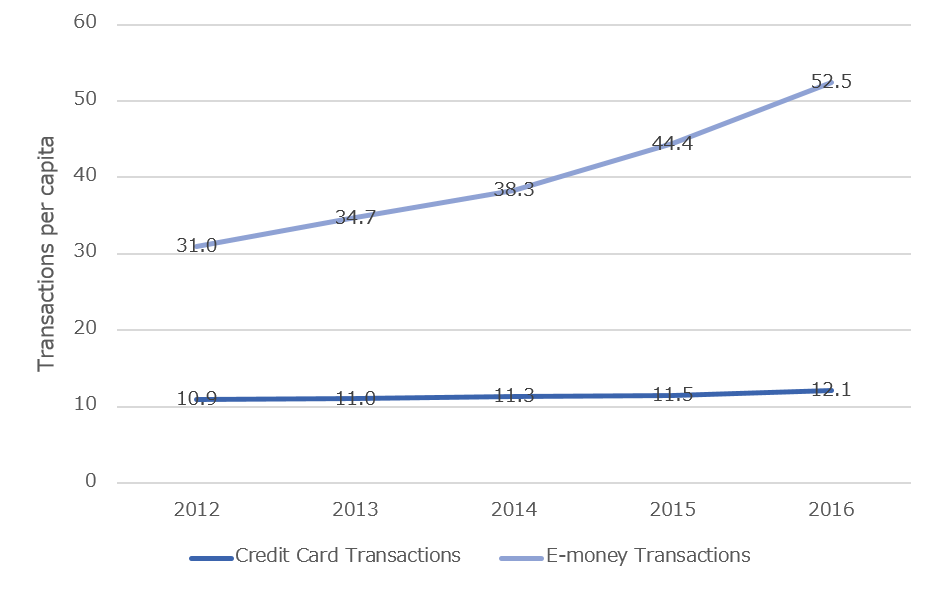 Source: Bank Negara Malaysia
In 2016, BNM held 20 roadshows in nine states around the country in collaboration with the Association of Bankers in Malaysia (ABM), the Association of Islamic Banking Institutions Malaysia (ABIM), and the National Cards Group (NCG). These annual roadshows are intended to (1) create awareness among individuals and businesses about the benefits of e-payments, its features, access, and pricing and (2) educate the public on safe practices in conducting financial transactions. They also provide banks an opportunity to showcase their new products in card acceptance and online banking. In addition, attendees can enjoy promotional offers from participating banks and payment system operators. Further, in 2016, BNM launched a new Real-Time Electronic Transfer of Funds and Securities (RENTAS) system in collaboration with its wholly owned subsidiary, MyClear. The new system will introduce (1) multi-currency settlement functions, (2) the adoption of ‘Society for Worldwide Interbank Financial Telecommunication’ (SWIFT) messaging standards, and (3) a gridlock resolution mechanism to enable the settlement of pending transactions. The new system reduces credit risk while providing fast and secure real-time settlements, but requires high liquidity levels. The new system was launched as the old system was reaching maturity, with its transaction volume at a steady 4.4 million over 2014-16 (transaction value, on the other hand, fell 3.8% YoY to MYR 51.5 trillion in 2016, following 9.0% YoY growth in 2014; this decline could have been due to inefficiencies in the older system, and the new system could rectify these). RENTAS Transaction Value Declines in 2016; Volume Steady
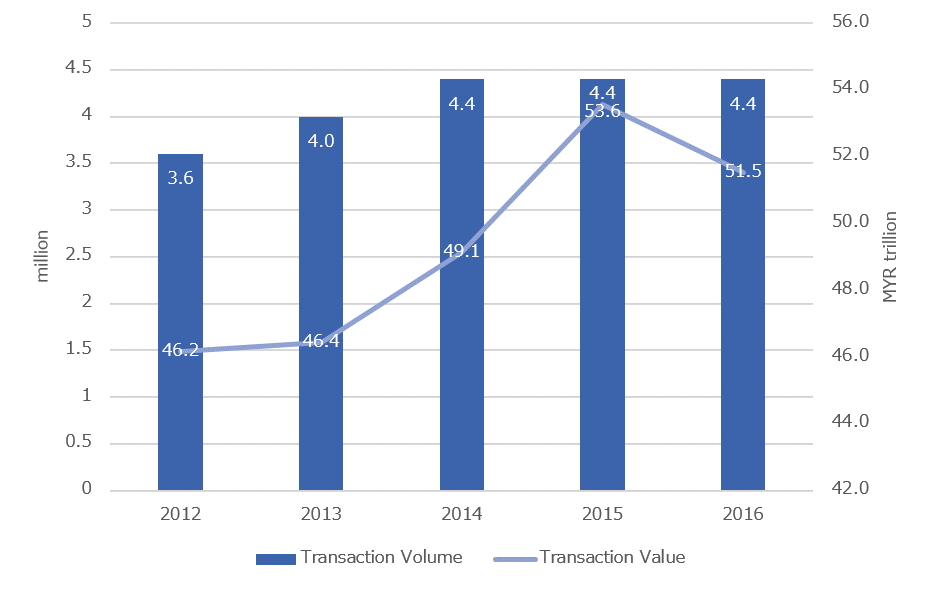 Source: Bank Negara Malaysia |
|
Debit Card Transactions: Reaching 2020E Target Unlikely Debit card transactions per capita grew at a CAGR of 29.7% over 2012-16. Moreover, with 3.4 debit card transactions per capita in 2016, Malaysia is far behind its target of 30.0 transactions per capita by 2020E. The target will be missed unless it achieves a CAGR of at least 72.3% over 2016-20E. As per Statista, the debit card penetration in Malaysia is expected to increase to 69.4% by 2020E, from 57.1% in 2016, which will still be well behind New Zealand’s 188.0% in 2011. In comparison, debit card penetration is also well below Singapore’s 93.3% in 2016 (95.7% by 2020E). Debit Card Transactions Gradually Up
 Source: Bank Negara Malaysia
In an effort to facilitate cashless payments and increase the security of card payments, BNM implemented a project to migrate to a Personal Identification Number-based (PIN-based) card system in 2017. Accordingly, in terms of infrastructure, 99.8% of point-of-sale (POS) terminals were upgraded to accept PIN authorisations by end-April 2017, while 96.1% of POS-active debit cards and 100.0% of credit cards were replaced. As per the Association of Bankers in Malaysia (ABM), complete migration was not achieved by end-April (two months ahead of the deadline) amidst general reluctance to change. However, if cards and terminals had not been replaced by 1 July 2017, merchants would not have been able to accept card payments. Additionally, Visa and other card issuers are working with merchants to train cashiers. Meanwhile, banks are working on improving awareness and education among customers so that the full benefit of the PIN system can be realised. Share of PIN-based Transactions at Four-Fifths on Approach of Replacement Deadline of 1 July 2017
 Source: Bank Negara Malaysia |
|
EFTPOS Terminals: Behind Target EFTPOS terminals per 1,000 inhabitants grew at a CAGR of 19.5% to 10 terminals per 1,000 in 2016 from 7 in 2014 and 8 in 2013. The decline in terminals in 2014 was due to population growth being faster than the rate of terminal additions. Growth in the number of terminals needs to reach a minimum CAGR of 25.7% over 2016-20E if the country is to meet its target of 25 terminals per 1,000 inhabitants by 2020E. EFTPOS Terminals Per Capita Steadily Up, Except in 2014
 Source: Bank Negara Malaysia |
|
Cheques: On Track to Reach 2020E Target BNM has succeeded in limiting the use of cheques: the number of cheques used declined at a CARC of 10.1% over 2012-16 to 133.1 million in 2016 from 203.8 million in 2012. If the rate of decline does not fall below 6.9% over 2016-20, Malaysia will be on track to achieving its targeted 100 million cheques by 2020. In its efforts to reduce the use of cheques, BNM initiated a pricing reform framework in 2013 to make e-payments more affordable. The price per interbank GIRO (IBG) transaction performed via internet banking or mobile banking was reduced by 95.0% to MYR 0.1 from MYR 2.0. Moreover, with effect from January 2015, banks began to charge MYR 0.5 on the issuer of a cheque in addition to stamp duty of MYR 0.15 per leaf. This charge was to progressively increase to reflect the true production cost of MYR 3.0 per cheque (as of 2013). The increase in the cost of issuing cheques, combined with the lowered price of IBG transactions, was intended to promote migration to e-payments as the more cost-effective option. Due to successful price signalling, IBG transactions grew at a CAGR of 25.5% to 174.1 million over 2012-15. Transaction volume grew 36.2% YoY in 2014 in response to price reforms introduced in 2013 and then slowed to 16.8% YoY in 2016 as the market adjusted to the reforms. Plans to Reduce Use of Cheques Successful as Mid-term Target Is Surpassed; IBG Transactions Steadily Up
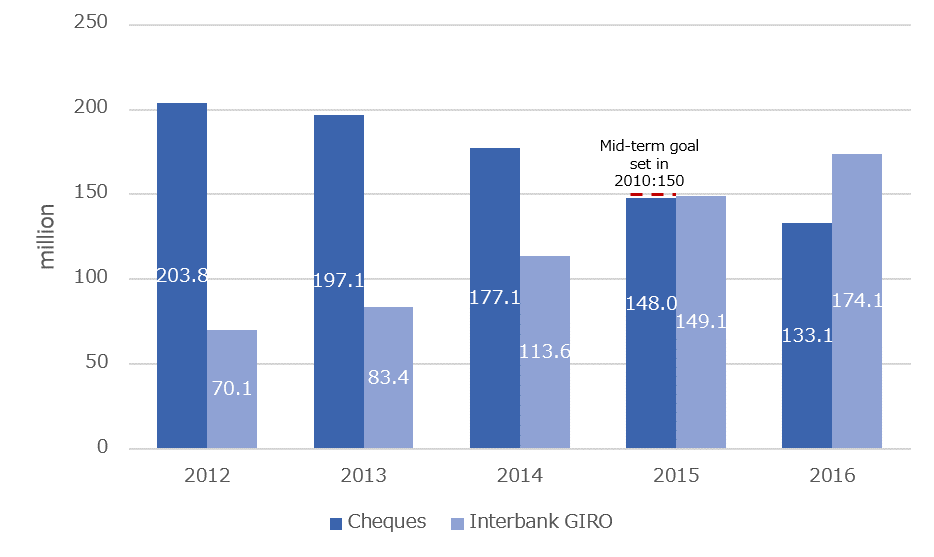 Source: Bank Negara Malaysia |
|
Older Generation’s and Small, Rural Merchants’ Reluctance to Change Poses Challenge on Path to Cashless Society Cyber security concerns, phishing attacks, and credit card fraud have contributed to a reluctance to progress towards a cashless society, especially among the older generation. Furthermore, small merchants in rural areas have been slow to accept e-payment systems, preferring cash and even imposing minimum charge policies for credit card payments. This highlights a lack of awareness among merchants of the fact that bank commission for credit cards is either fixed or reduces with increased credit card transactions. |
|
At Current Rates, Malaysia Unlikely to Achieve Targets by 2020 Reporting on the status of its targets in its current annual report, BNM stated that more than half of its projects to achieve greater economic efficiency through electronic payments are on track (53.0%), with 26.0% already completed and 21.0% either under review or yet to commence. Majority of Projects Promoting Greater Economic Efficiency through Electronic Payments Are Completed or On Track
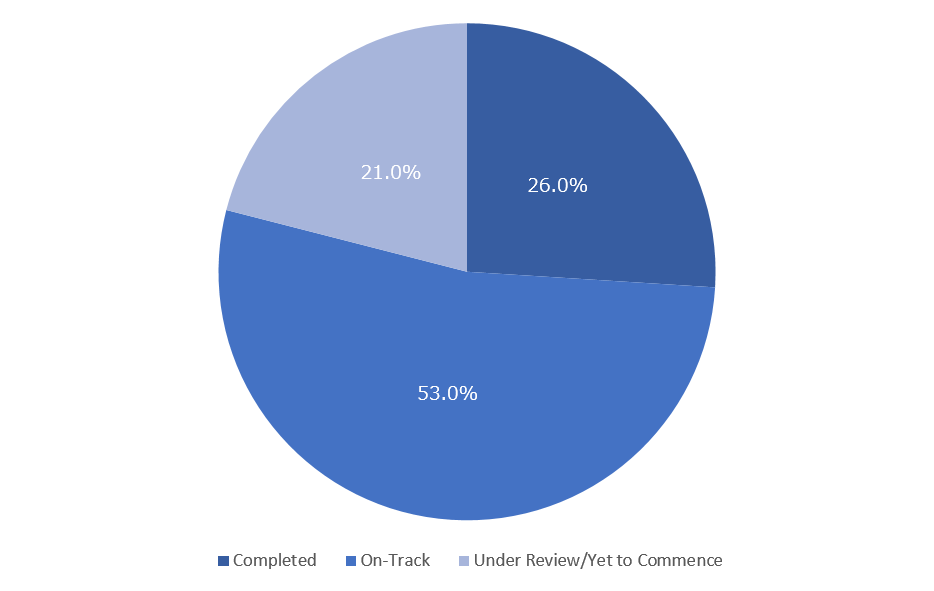 Source: Bank Negara Malaysia
By end-2016, Malaysia has not met the halfway marks of three of its four targets for 2020E. While the country is on track to meet its goal of reducing the use of cheques, it has fallen short in its targets relating to e-payments per capita, debit card transactions, and EFTPOS terminals. Consequently, Malaysia is unlikely to meet its targets over the three and a half years to 2020E. Malaysia Falls Behind in 2016 in the Achievement of 2020E Targets
Source: Bank Negara Malaysia
A potential catalyst is the increasing proportion of the population that is comfortable with the use of technology, as young, technologically conversant consumers continue to qualify to carry out financial transactions. This could lead to a slightly faster pace of growth in the achievement of the central bank’s four targets. Nevertheless, in the absence of additional initiatives by BNM over the next three years, Malaysia’s migration to a cashless society is still some way off. Growing Proportion of Technologically Conversant Population a Potential Catalyst for E-Payments Growth
Source: Population Pyramid |
|
Appendix: Five-Part Plan in BNM’s Financial Sector Blueprint 2011-2020  Source: Bank Negara Malaysia |




